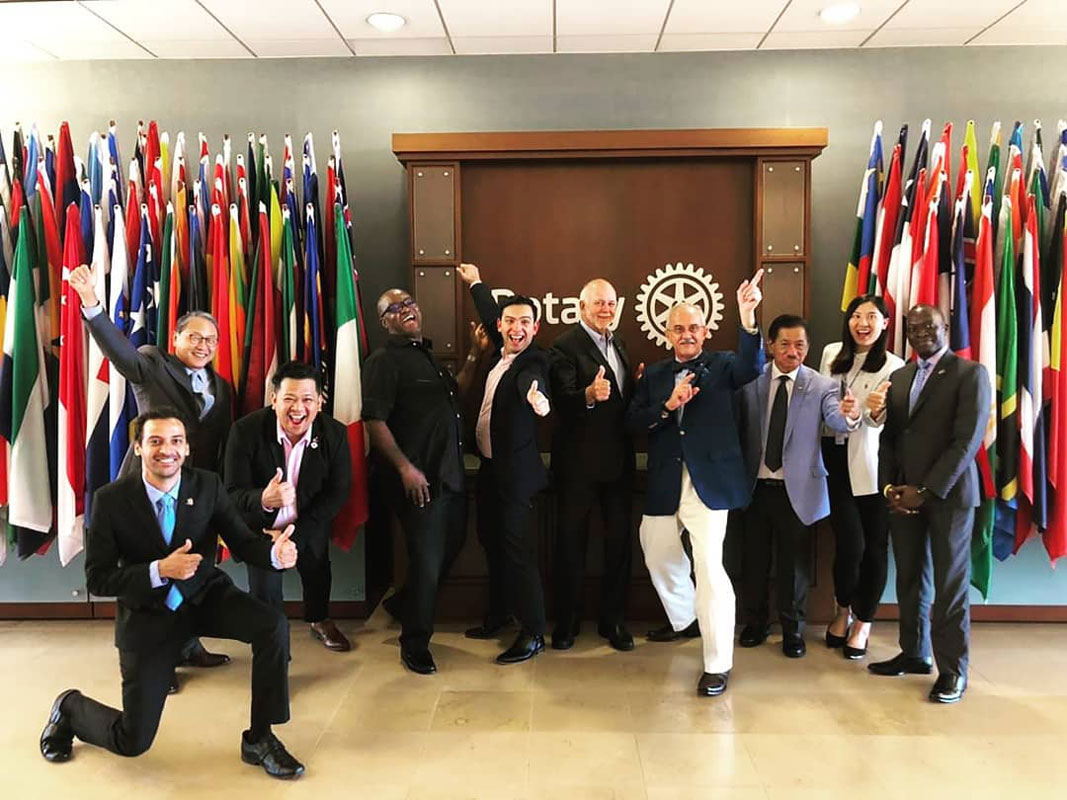Rotaract annual dues pegged at $5 & $8

Beginning 2022, Rotaractors of university-based clubs will have to pay annual dues of $5 and community-based clubs $8. The dues have been introduced to cover the cost of additional support for Rotaract clubs, which can participate in global grant projects from July 1, 2022. They can be international or host sponsor of a global grant if they have previously partnered with a Rotary club on a similar grant. This was announced by the Elevate Rotaract Task Force Chair David Stovall at a breakout session of the RI Virtual Convention. At this session PRIP Barry Rassin, Rotaract Committee Co-chairs Elyse Lin from Taiwan and Ronald S Kawaddwa from Uganda discussed various changes following the resolution to elevate Rotaract, which was passed at the CoL 2019.
Rassin had formally proposed expanding the definition of Rotary membership to include both Rotary and Rotaract at the CoL “to make Rotary more appealing and welcoming to young professionals. We keep telling Rotarians to find a way to bring in young people, when we have them already, but we seem to forget them,” he said.
The Task Force, comprising both Rotaractors and Rotarians, was created last year by President Mark Maloney to discuss ways to update Rotaract policies and create an inclusive and flexible membership experience. “We included Rotaractors world over in a survey to look into what services Rotary can offer Rotaract. The focus was to give more autonomy and flexibility to Rotaractors and treat them as equal partners,” said Stovall.
I’d want all Rotaractors from community-based clubs to stay in Rotary.
— PRIP Barry Rassin
With Rotaractors now having Rotary membership, they will get more support from RI, including access to administrative tools on My Rotary, take advantage of products and services such as new leadership development resources from Toastmasters International, updated online goal-setting tools and an improved online club administration experience.
On the advice of the Task Force, the RI Board in October 2019 approved several changes to Rotaract — the most notable being the removal of Rotaract’s upper age limit. From July 1, Rotaractors will no longer be required to leave their club when they turn 31.
The Task Force observed that only 4 per cent of Rotaractors were becoming Rotarians. “That means we have lost most of the Rotaractors who could have stayed with Rotary,” said Kawaddwa. The age limit was an obstacle for Rotaract members who wanted to stay involved with Rotary but either didn’t feel ready for a traditional Rotary club or found Rotary dues expensive. “Once those members leave, it’s very hard to get them back into the Rotary family. With the rules changed, hopefully some recent alumni will rejoin Rotaract,” said Elyse.
There was a concern that Rotaractors will never move on to Rotary and Rotaract will be slowly taken over by older members. “Rotary clubs need to transform themselves to be more relevant to the younger Rotaract members so that they want to join a Rotary club,” said Rassin. To the Rotaractors, he said, “If you can’t find a Rotary club that you want to join, you can form a new one.”

It’s all about individual relationships. Rotarians should frequent their Rotaract clubs and vice versa. “Rotaractors will not have any reason to join a Rotary club where they don’t know others. When they do service and fellowship together, they are likely to to stay together,” he said.
Elyse highlighted another concern worrying Rotaractors. Many of them feel that their club leadership team will become older when the age limit is removed. However, Rassin pointed out, Rotaract clubs will still be able to set their own age limit, if they wish.
Letting Rotaract members stay in their clubs longer gives them more time to learn about Rotary, Kawaddwa said. “We hope that these changes will produce stronger Rotarians, members who have served longer and gotten more experience and mentorship while in Rotaract.”
Other changes
New Rotaract clubs won’t have to rely on a Rotary club to sponsor them; they can now sponsor themselves or choose another Rotaract club as their sponsor. And Rotaractors are now eligible and encouraged to serve alongside Rotarians on district and RI committees. Recognitions such as the citation for meritorious service and the Distinguished Service Award have now been extended to Rotaractors too.
Goals
RI has set a 100 per cent increase in the number of Rotaractors reported to Rotary by 2022 and 20 per cent increase in the number of Rotaractors joining Rotary clubs. “We have to move from the present rate of 4 per cent. I’d want all Rotaractors from community-based clubs to stay in Rotary,” said Rassin. Another goal is one million Rotaractors by 2029.
“We set audacious goals. Some thought I was crazy. But I truly believe these goals are achievable. I have an incredible belief in the possibilities of Rotaractors,” said Rassin.
